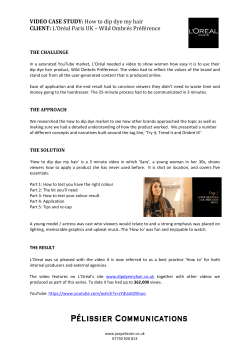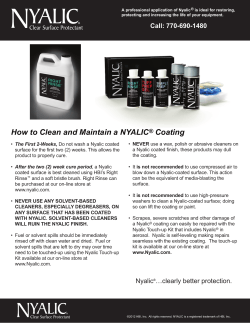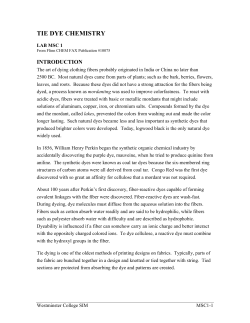
Epoxies Used in Tensile Testing:
Epoxies Used in Tensile Testing: Film vs. Liquid-Why is There a Difference? John P. Sauer Sauer Engineering, Cincinnati, Ohio, USA Steve Ruoff IMR Test Labs, Ithaca, New York, USA Abstract Tensile testing of thermal spray coatings is currently covered by a variety of internal company specifications and generally by ASTM C-633. It is a highly recognized fact that liquid epoxies, on average, produce higher results in side by side comparisons with their film counterparts. However, the liquid epoxies show a higher standard deviation in those same comparisons. This raises questions about the interaction of liquid epoxies with porous thermal spray coatings. Tensile data from side by side comparisons was analyzed and optical microscopy work performed to determine how the epoxies affected the coatings and if the epoxy infiltration actually occurs. In the case of porous plasma coatings, it is shown that liquid epoxies penetrate into the coatings and, thereby, increase the apparent tensile strength. Introduction Tensile testing is one of the many evaluation tools used to examine the quality level of thermal spray coatings. This general technique is controlled by ASTM C-633 [1] and numerous company driven specifications. With many governing documents, there is considerable variation in control of critical parameters such as testing thickness, bonding fixture, test specimen type (button vs. adaptor), and adhesive type (film vs. liquid epoxy). This paper will focus on comparing adhesive types and how the choice affects final strength values. Background Tensile testing of thermal spray coatings produces data about the material deposit and provides answers to questions such as: § Is grit blasting adequate for good adhesion or bonding to the substrate? (adhesive properties) § What is the strength of bonding within the spalts of the coating? (cohesive properties) § For abradable coatings, is the proper combination of porosity-metallic-nonmetallic phase present in the microstructure? (correlation with metallographic data) When tensile testing of thermal spray coatings became widespread in the early 70’s, liquid epoxies such as EC 2214 and EC 2086 were the only adhesives available to accomplish the task. As abradable coatings have grown in usage, it became apparent that liquid epoxies would not be acceptable for tensile testing. The identified problem was penetration of the epoxy into the “very porous” abradable coating resulting in “strength improvement” by supporting the structure before ultimate failure. A film epoxy, FM 1000, was identified that does not penetrate and is now commonly required for “low strength” or abradable coatings. For coatings above an arbitrary or expected value of let’s say 24.1 MPa, most specifications allow either liquid or film epoxies. However, recent publications and a paper by Evans (1996) [2] show that for a yet undetermined reason, use of liquid epoxy on typically porous plasma coatings will usually result in higher values (sometimes > 17.2Mpa higher) when compared to the same tests using film FM 1000 epoxy. For dense HVOF materials with expected strengths above 68.9 MPa, this difference is not observed. These observations support an investigation of porosity infiltration into the plasma coatings by liquid epoxy as was observed on the abradable materials. Procedure To validate this theory, a combination of tensile testing and metallography was used on buttons coated with both plasma and HVOF thermal spray methods. Table 1 details the coatings used in the evaluation. Table 1: Coating Types. Coating Nominal Thickness Deposition Method TBC .127 mm Plasma NiAl .178 mm Plasma NiAl .254 mm HVOF The obvious evaluation method to answer the tensile adhesive question is side by side tensile testing using both liquid and film epoxies. However, the ultimate goal is verification that the increase in strength level is indeed caused by the infiltration of the liquid epoxy. It is common practice to mix fluorescent dye into metallographic mounting materials to identify porosity in a metallographic cross section. To verify use of this methodology in tensile epoxies, the fluorescent dye was mixed into the liquid tensile epoxy and an epoxy only test was performed. Comparison of this result with the normal epoxy only database indicated no change in strength level. The tests for this evaluation were therefore performed with fluorescent dye filled liquid tensile epoxy. Metallographic mounts were made using the logic in Table 2. Results on tensile tested and mounted buttons. The data clearly shows the liquid tensile epoxy penetrates thru to the substrate on both the plasma single layer NiAl deposit and the bond coat/topcoat TBC system. This is illustrated by the presence of fluorescent dye in mounted cross sections when considering the source of the fluorescent media. However, the more telling evidence is the failure location within the coating for the TBC specimens. For this coating, the film FM 1000 bonded specimens fail in the top 1/3 of the coating thickness supporting no impregnation. Conversely, the liquid EC 2214 bonded samples all fail in the bottom 1/3 supporting substantial impregnation of the tensile epoxy. The amount of impregnation will probably vary with the amount of porosity in the coating but this was not a part of the current review. (a) Tensile Tensile results are summarized in Table 3. All specimens used for this evaluation were one (1”) diameter buttons. As mentioned earlier, the EC 2214 liquid epoxy was mixed with a fluorescent dye and then cured at 149°° C for 2 hrs in a bonding fixture with minimal clamping. The FM 1000 film epoxy was cured in a gravity fixture (70 degrees) at 199°° C for 1.5 hrs. Curing cycles were based upon industry practice and IMR experience. Metallography Metallographic work was performed on both untested and tested buttons. Figures 1 thru 3 represent the microstructure of the plasma TBC, plasma NiAl, and HVOF NiAl, respectively. The substrate is at the bottom in all photomicrographs. Mounting material with fluorescent dye was used to prepare the specimens as evidenced by the fluorescent filter photos shown in item (b) of Figs. 1 thru 3. The fluorescent filter pictures were produced using a green excitation filter with a wavelength of 530-550 nm. As expected, the plasma coatings exhibit substantial porosity with the voids filled by mounting material containing fluorescent dye. Figures 4 thru 8 represent cross sections of the tested button specimens. Table 4 summarizes the results of the observations (b) Figure 1: Plasma TBC-mounted with fluorescent dye-untested button-both bright field (a) and fluorescent filter (b). Conclusions Tensile testing on plasma and HVOF coatings involving a side by side comparison of film vs. liquid epoxies has shown the following. § For porous plasma coatings, the liquid epoxy penetrates into the coating which raises the tensile strength. This is supported by both metallographic fluorescent dye data and the failure location in the TBC samples which is in the bottom 1/3 of the coating. § For porous plasma coatings, the film epoxy does not penetrate into the coating and raise the tensile strength. This is supported by both metallographic fluorescent dye data and the failure location in the TBC samples which is in the top 1/3 of the coating. § For dense HVOF coatings, neither the liquid or film epoxies penetrate into the coating and the tensile strength for either method is the same. This is supported by both metallographic fluorescent dye data and the similar failure locations. 2. Evans, K.A., Tensile Bond Strength Variance of Thermally Sprayed Coatings with Respect to Adhesive Type, Practical Solutions for Engineering Problems, C.C. Berndt (Ed.), Published by ASM International, Materials Park, Ohio-USA, 1996, pp.803-806 Further work to substantiate this dependence would concentrate on level of porosity in the plasma coating, thickness of the coating, and viscosity of varied liquid epoxies. This work is planned for the next ITSC. (a) Acknowledgements The authors would like to acknowledge the efforts of Fred Anderson, Jim Andrews, Ron Hughey, Ed Brothers, and Jody Russell from IMR Test Labs in the preparation of metallographic mounts and the tensile testing of samples. TBC samples were provided by Kevin Young of Progressive Technologies and NiAl samples by Rick Bajan of Turbine Component Technologies. References 1. Anon., ASTM Designation C633 - Standard Method of Test for Adhesion or Cohesive Strength of Flame Sprayed Coatings, in 19th Annual Book of ASTM Standards, Part 17, American Society for Testing and Materials, Philadelphia, PA, USA, 1969, pp. 636-642 (b) Figure 2: Plasma NiAl-mounted with fluorescent dye-untested button-both bright field (a) and fluorescent filter (b). (a) (b) Figure 3: HVOF NiAl-untested button-both bright field (a) and fluorescent filter (b). (a) (a) (b) Figure 4: Plasma TBC-tested button with EC 2214 showing fluorescent epoxy from tensile adhesive in coating porosity-both bright field (a) and fluorescent filter (b). (a) (b) Figure 5: Plasma TBC-tested button with FM 1000 showing fluorescent epoxy from mounting material in coating porosity-both bright field (a) and fluorescent filter (b). (a) (b) Figure 6: Plasma NiAl-tested button with EC 2214 showing fluorescent epoxy from tensile adhesive in coating porosity-both bright field (a) and fluorescent filter (b). (a) (b) Figure 7: Plasma NiAl-tested button with FM 1000 showing fluorescent epoxy from mounting material in coating porosity-both bright field (a) and fluorescent filter (b). (a) (b) Figure 8: HVOF NiAl-tested button from either EC 2214 or FM 1000 showing no fluorescent epoxy from mounting material or tensile adhesive in coating porosity-both bright field (a) and fluorescent filter (b). Table 2: Mounting Media for Varied Samples. ........ Specimen Mounting Material Logic Untested button Mounting media with fluorescent dye The use of the fluorescent dye will identify the “true” porosity level in the coating before tensile testing Tested button with liquid epoxy and fluorescent dye Mounting media with no fluorescent dye If fluorescent dye is viewed within the coating and there is no dye in the metallographic mount, the only source of the fluorescence is penetration of the liquid tensile epoxy. Tested button with film epoxy and no fluorescent dye Mounting media with fluorescent dye If fluorescent dye is viewed within the coating, the only source would be the metallographic mounting material. This indicates the FM 1000 material did not impregnate the coating during curing and the presence of dye in the coating is from the mounting material during vacuum impregnation. Table 3: Tensile Results. Coating Epoxy Result (Mpa) Failure location Plasma TBC (Metallography) FM 1000 FM 1000 27.8 29.3 Coating Failure Coating Failure EC 2214 EC 2214 43.0 42.8 Coating Failure Coating Failure FM 1000 FM 1000 28.1 29.6 Coating Failure Coating Failure EC 2214 EC 2214 64.8 62.5 Coating Failure Coating Failure FM 1000 FM 1000 35.2 33.8 Coating Failure Coating Failure EC 2214 EC 2214 43.8 45.8 Coating Failure Coating Failure FM 1000 FM 1000 65.4 64.9 Epoxy Failure Epoxy Failure 66.5 57.4 Epoxy Failure Epoxy Failure Plasma NiAl Set #1 Plasma NiAl Set #2 (Metallography) HVOF NiAl (Metallography) EC 2214 EC 2214 Results for epoxy only pulls are nominally above 68.9 MPa Table 4: Metallographic Results. Coating Figure Condition Mounting Media Logic Actual Result Plasma TBC Figure 4 Tested with EC 2214 –fluorescent dye in tensile epoxy No dye in mounting media If fluorescent dye is viewed within the coating and there is no dye in the metallographic mount, the only source of the fluorescence is penetration of the liquid tensile epoxy. Fluorescent dye is present in the mounted cross section-only source of dye is tensile epoxy data supports impregnation of tensile epoxy -failure location is also bottom 1/3 of coating. Figure 5 Tested with FM 1000-no dye in tensile epoxy Fluorescent dye in mounting media If fluorescent dye is viewed within the coating, the only source would be the metallographic mounting material. This would indicate the FM 1000 material did not impregnate the coating during curing and the presence of dye in the coating is from the mounting material during vacuum impregnation. Fluorescent dye is present in the mounted cross section-only source of dye is mounting material-data supports no impregnation of tensile epoxy failure location is also top 1/3 of coatin g. Figure 6 Tested with EC 2214 –fluorescent dye in tensile epoxy No dye in mounting media If fluorescent dye is viewed within the coating and there is no dye in the metallographic mount, the only source of the fluorescence is penetration of the liquid tensile epoxy. Fluorescent dye is present in the mounted cross section-only source of dye is tensile epoxy data supports impregnation of tensile epoxy. Figure 7 Tested with FM 1000-no dye in tensile epoxy Fluorescent dye in mounting media If fluorescent dye is viewed within the coating, the only source would be the metallographic mounting material. This would indicate the FM 1000 material did not impregnate the coating during curing and the presence of dye in the coating is from the mounting material during vacuum impregnation. Fluorescent dye is present in the mounted cross section-only source of dye is mounting material-data supports no impregnation of tensile epoxy. Figure 8 Tested with EC 2214 –fluorescent dye in tensile epoxy No dye in mounting media If fluorescent dye is viewed within the coating and there is no dye in the metallographic mount, the only source of the fluorescence is penetration of the liquid tensile epoxy. No fluorescent dye present in mounted cross section-failure was epoxy only in testingcoating is dense and no impregnation occurs -there was also no difference in tensile results with either epoxy Same as Figure 8 Tested with FM 1000-no dye in tensile epoxy Fluorescent dye in mounting media If fluorescent dye is viewed within the coating, the only source would be the metallographic mounting material. This would indicate the FM 1000 material did not impregnate the coating during curing and the presence of dye in the coating is from the mounting material during vacuum impregnation. No fluorescent dye present in mounted cross section-failure was epoxy only in testingcoating is dense and no impregnation occurs -there was also no difference in tensile results with either epoxy Plasma NiAl HVOF NiAl
© Copyright 2025









